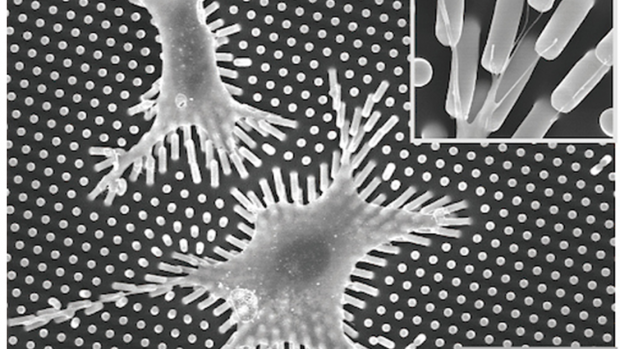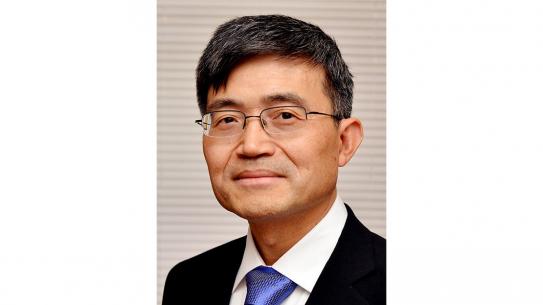Research using mechanics and physics could predict diseases that cause cells to stress
Finding energy patterns in the physical behavior of cells under local stress, NYU Tandon researchers identify targets for diagnosis and treatment of conditions like hypertension, diabetes and aneurisms.

Elastic polydimethylsiloxane (PDMS) micropillars seeded with vascular muscle cells let researchers quantify cellular force and energy during allostasis
BROOKLYN, New York, Monday, August 19, 2019 – Researchers at the NYU Tandon School of Engineering have discovered a new way to identify the state of individual cells by bringing principles of mechanical engineering and physics to bear on processes that are now well understood at the macro level, but not yet at the cellular level: how stressors such as injury and disease force an organism into a new level of equilibrium — a biological process of finding a “new normal” called allostasis. The researchers’ findings carry major implications for the diagnosis and staging of chronic diseases like hypertension and diabetes.
The team, led by Weiqiang Chen, assistant professor of mechanical and aerospace engineering and of biomedical engineering, and Vittoria Flamini, industry assistant professor of mechanical and aerospace engineering, used live cell imaging and a novel micro-mechanical tool to apply a transient, local physical stress on cells while simultaneously measuring dynamic allostatic responses and the tension of the cells’ cytoskeleton (CSK) and other cellular structures and cellular energies.
The study, “Energy-Mediated Machinery Drives Cellular Mechanical Allostasis,” which will be featured in Advanced Materials, details how the team measured mechanical stress and energies of cells and compared the stress patterns to those of cells in patients with chronic conditions like type II diabetes, allowing them to build predictive models for diabetes and other conditions.
To study how the cells “remodeled” themselves through mechanical and energy-related processes in response to external stimuli, the team employed a “tweezer” developed by Chen that uses ultrasound pulses and “microbubbles” that attach to the cell membrane and — as the pulses perturb the bubbles — exert mechanical forces on the cells. The team embedded the vascular-muscle test cells in a substrate comprising elastic polydimethylsiloxane (PDMS) micropillars. This setup allowed them to quantify cellular force and energy during the operation by measuring deflections of the micropillar substrate; fluorescent microscopy allowed the team to visually monitor how stress reorganized the CSK, especially its constituents actin and myosin that, like metal fibers in a steel-belted radial tire, can become dysfunctional and deformed under force.
Using experimental results, the team built a new biophysical model of energy-driven cellular machinery for understanding allostasis in cells. In this process, cellular energy not only provides the driving power for adaption but also a negative feedback to help in restabilizing the cell’s system.
“A skewed energy pattern and cell maladaptation may indicate a transformation of healthy condition into a pathological contexts, such as diabetes, hypertension, or aging,” said Chen.
The researchers tested their model on four presentations of CSK tension, actin and myosin, and net energy, before, during and after the introduction into cells of chemical agents that generate specific dysfunctional cellular patterns that are phenotypes for disease: For example, disruption in such cell CSK structures as actin fibers can result in a weak adaptative process which may reveal pathological condition like diabetes, while over-activity in actin polymerization in cells may cause “prolonged excitation” or “hypo-reactivity” without an “off” time after a perturbation in conditions like hypertension.
“Energy balance is a proxy for health,” said Flamini. “Energy and physics are involved in cellular behaviors; proof of concept is how the energy pattern looks for different conditions. We have shown we can predict that.”
“The ability to achieve stability through change is a critical biological adaptation allowing living organisms to stabilize internal and external environment changes,” she explained. “However, it remains unclear how it happens in a single cell. Our research addressed this question for a single cell system in which energy plays a key role in the process.”
Added Weiqiang, “In collaboration with colleagues at NYU Langone Health, the team is focusing on cardiovascular diseases because they are directly related to mechanical behaviors of vascular cells. In an aneurysm, for example, inflammation affects proteins that regulate the elasticity of vascular cells. We are now looking at mechanical force in development of diseases like this.”
A forthcoming paper will look at the potential of this research to expedite disease diagnosis and disease staging in aneurysm.
The paper, “Energy-Mediated Machinery Drives Cellular Mechanical Allostasis,” is available at https://onlinelibrary.wiley.com. This research is funded by the American Heart Association Scientist Development Grant, and a New York University Global Seed Grant.
Note: Images available at https://nyutandon.photoshelter.com/galleries/C0000DKT3j1lAvpA/G00003AdsI2Ehs3A/Chen-Flamina-Cellular-Allostasis
About the New York University Tandon School of Engineering
The NYU Tandon School of Engineering dates to 1854, the founding date for both the New York University School of Civil Engineering and Architecture and the Brooklyn Collegiate and Polytechnic Institute (widely known as Brooklyn Poly). A January 2014 merger created a comprehensive school of education and research in engineering and applied sciences, rooted in a tradition of invention and entrepreneurship and dedicated to furthering technology in service to society. In addition to its main location in Brooklyn, NYU Tandon collaborates with other schools within NYU, one of the country’s foremost private research universities, and is closely connected to engineering programs at NYU Abu Dhabi and NYU Shanghai. It operates Future Labs focused on start-up businesses in downtown Manhattan and Brooklyn and an award-winning online graduate program. For more information, visit http://engineering.nyu.edu.




